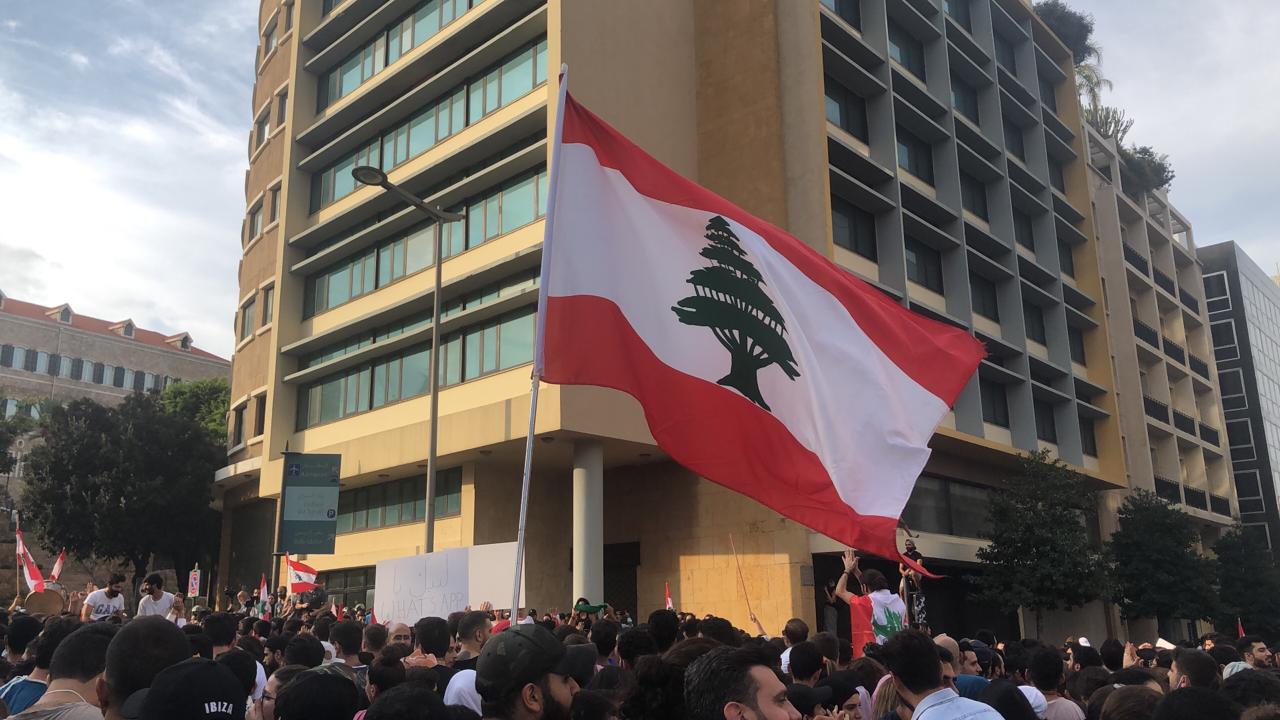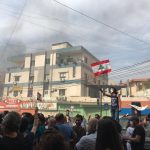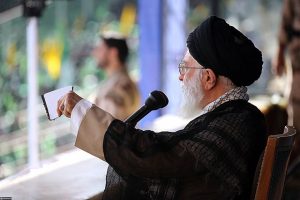By Emile Nakhleh
Lebanon’s largely peaceful “Arab Spring” is a model in civic activism for the greater Middle East. Prime Minister Saad Hariri’s offer to resign in response to the country’s popular uprising, which has been devoid of bloodshed and mayhem, is starkly different from the response of regimes to the first Arab spring in 2011. It’s also different from the Iraqi government’s bloody response to protests in Baghdad even though following the killing of hundreds of demonstrators, the Iraqi prime minister has also offered to resign.
Yet, the Lebanese uprising, peaceful as it is, poses a serious challenge to the very existence of the Lebanese state. It has also shaken the clerical regime in Iran and is an ominous harbinger for the neighboring Arab rulers. Lebanon is a precarious state in which trash has been piling up, public services and utilities have been sporadic, and the desire to leave the country has been the overwhelming concern of so many Lebanese.
Attaining a new political order free of sectarianism and corruption in Lebanon is a tall order, rendering the likelihood of success minimal. The Beirut demonstrations are patently indigenous and locally-driven. The demands for justice and dignity have targeted corruption and all corrupt politicians regardless of their sect, religion, and social status. “All means all,” shouted the demonstrators. Not just the Prime Minister, but all politicians, including the Hezbollah-supported Maronite President Michel Aoun, all the ministers, and other high-level officials who have benefitted from corruption through partisan patronage positions and other shady deals. Eight years ago, the popular revolts were opposed by Arab rulers but supported by the Iranian regime. The on-going uprisings in Lebanon and Iraq are opposed by Iranian and Arab regimes.
Although the Lebanese popular movement is not religious, its key demand for a new secular and corruption-free order strikes at the very existence of Lebanon, which also makes the current protest movement so unique in the modern annals of the Arab world. The previous Arab Spring aimed at regime change in Tunisia, Egypt, Yemen, and Libya, but street protests in Lebanon have attacked the religious edifice of Lebanon.
Arab autocratic regimes are worried that the protest virus will inflict their societies and threaten their hold on power. Iran and its proxies in Lebanon and Iraq, including Hezbollah and the Da’wa Party, are concerned because any serious change in the existing power alignments in the two countries will seriously undermine Iran’s political influence in both countries. This fear is what has driven Hezbollah’s leader Hassan Nasrallah and Iran’s Supreme Leader Ayatollah Ali Khamenei to denounce the protests as the work of “foreign hands,” presumably the United States and Israel.
Qasem Sulaimani, the head of Iran’s Quds Force, recently urged Iraqi leaders to respond to street protests as harshly as the Iranian leadership did in suppressing the “Green Revolution” of 2009 in Iran. What he has discovered on his recent visit to Baghdad’s Green Zone is that 2019 is vastly different from 2009. Iraqi youth stayed in the streets despite the government’s violent response.
Iran’s clerical regime and Arab autocrats seem incapable of halting Arab publics’ rejection of humiliation, and their persistent demands to root out corruption from their societies and hold their leaders accountable. Instead, Arab and Iranian autocrats and their proxies have been impugning the motives of the demonstrators and belittling the objectives of the new “Arab Spring.”
In Lebanon, Nabih Berri, leader of the other Shia party Amal and Speaker of the Parliament, much like Hezbollah’s leader Nasrallah, has also hued the Iranian line in denouncing the protest movement. He and his ilk are worried that they might lose the sectarian golden goose that has hatched and nurtured corruption in Lebanon in the past half century. A bit of history is illustrative.
A brief history of Lebanon’s “confessionalism”
Lebanon was established as an independent state in 1943 with a “confessional” or religious system of government in which senior leadership positions were allotted on the basis of religious or sectarian affiliation. The so-called National Charter prescribed, for example, that the President of the Republic will be a Maronite, the Prime Minister a Sunni Muslim, and the Speaker of Parliament a Shia Muslim. In the early years of independence, the minister of defense was always a Druze, and the Minister of Foreign Affairs was always a Greek Catholic. The Christian community, which according to the 1932 census was a majority, wanted to preserve its status as a privileged majority. Of course, the demographic make-up of the population has dramatically changed since then, with Muslims now accounting for more than 50 percent of all Lebanese.
Sectarianism and the 1975-1990 civil war have contributed to systemic instability and government paralysis. The confessional basis of the political system was reaffirmed following the civil war with the Ta’if agreement of 1989, which also extended Lebanese sovereignty to the southern part of the country that was occupied by Israel. The Israeli occupation that began in 1982 ended in 2000. The Syrian occupation that started in the early years of the civil war ended in 2005.
The Ta’if accords allowed Syria to extend and deepen its military and security hegemony over Lebanon and indirectly empowered Hezbollah to emerge as the most powerful political party and king maker in Lebanese politics. Although the Syrians left Lebanon a decade and a half ago, Hezbollah continued to dominate the political landscape. In fact, President Michel Aoun and Prime Minister Sa’ad Hariri came to power only with the acquiescence of Hezbollah.
Unlike other militias that were forced to disarm following the Ta’if accords, Hezbollah has refused to disarm. Hezbollah has maintained that its ability to thwart Israel’s military assault in 2006 and to protect the border between Lebanon and Israel justifies its continued build-up of a credible weapons arsenal. Sadly, Hezbollah, at Iran’s behest, decided to participate in the Syrian civil war on insistence in the battle to keep Assad in power. Assad serves Iran’s interests in the Levant, and therefore it was logical for Hezbollah, as Iran’s regional proxy, to send its fighters to Syria to shore Assad up.
Regime response
Much to the consternation of regional autocrats and corrupt governments, the popular upheaval across the region continued unabated. Although the focus has been on Lebanon and Iraq, massive street protests also have been occurring in Algeria, Sudan, and elsewhere. The movement is indigenous, and the demands are for a better life, a more hopeful future, good governance, accountable leaders, and an end to humiliation are genuine. They stem not from a foreign instigation but from local conditions. The gap between the small excessively wealthy minority and the ever growing poorer, unemployed, and underemployed majority has increased exponentially.
Social media has played a significant role in mobilizing the crowds but not in starting the protest movement. Arab youth are keenly aware through social media of the economic and social conditions in their respective countries. Again, the reach of social media has made their deprivation, by comparison with their counterparts in Western societies, more stark, more intolerable, and less unacceptable.
If the Arab and Iranian regimes hope to survive, they should implement a new social contract with their peoples that would enshrine the people’s right to hold their economic and political leaders accountable. The days of banking and financial leaders as untouchable gnomes are long gone. Wealth accumulation should become transparent. The new social contract should delineate new rules for legitimate and illegitimate means of amassing wealth. Street protesters will tell you that there is no way on God’s earth that a cabinet member could become so wealthy overnight from his monthly salary. Acquiring of opulence through shady deals is the handmaiden of corruption, social and economic divisions, injustice, humiliation, and political instability.
This is what has driven thousands of people to the streets. If regimes do not understand this phenomenon and act on it, their security states and services will not be able to save them, and they will be swept away.





Just a recap- in case you have forgotten!!
Lebanese Civil War
The Sabra and Shatila massacre (also known as the Sabra and Chatila massacre)[4][5] was the killing of between 460 and 3,500 civilians, mostly Palestinians and Lebanese Shiites, by a militia close to the Kataeb Party, also called Phalange, a predominantly Christian Lebanese right-wing party in the Sabra neighborhood and the adjacent Shatila refugee camp in Beirut, Lebanon. From approximately 18:00 on 16 September to 08:00 on 18 September 1982, a widespread massacre was carried out by the militia under the eyes of their Israeli allies.[6][7][8][9] The Phalanges, allies to the Israeli Defence Forces (IDF), were ordered by the IDF to clear out Palestine Liberation Organization (PLO) fighters from Sabra and Shatila, as part of the IDF maneuvering into West Beirut. The IDF received reports of some of the Phalanges atrocities in Sabra and Shatila but did not take any action to prevent or stop the massacre.[10]
The massacre was presented as retaliation for the assassination of newly elected Lebanese president Bachir Gemayel, the leader of the Lebanese Kataeb Party. It was wrongly assumed by the Phalangists that Palestinian militants had carried out the assassination. In June 1982, the Israel Defense Forces had invaded Lebanon with the intention of rooting out the PLO. By mid-1982, under the supervision of the Multinational Force, the PLO withdrew from Lebanon following weeks of battles in West Beirut and shortly before the massacre took place. Various forces — Israeli, Phalangists and possibly also the South Lebanon Army (SLA) — were in the vicinity of Sabra and Shatila at the time of the slaughter, taking advantage of the fact that the Multinational Force had removed barracks and mines that had encircled Beirut’s predominantly Muslim neighborhoods and kept the Israelis at bay during the Beirut siege.[11] The Israeli advance over West Beirut in the wake of the PLO withdrawal, which enabled the Phalangist raid, was considered a violation of the ceasefire agreement between the various forces.[12] The Israeli Army surrounded Sabra and Shatila and stationed troops at the exits of the area to prevent camp residents from leaving and, at the Phalangists’ request,[13] fired illuminating flares at night.[14][15]
According to Alain Menargues, the direct perpetrators of the killings were the “Young Men”, a gang recruited by Elie Hobeika, a prominent figure in the Phalanges, the Lebanese Forces intelligence chief and liaison officer with Mossad, from men who had been expelled from the Lebanese Forces for insubordination or criminal activities.[16] The killings are widely believed to have taken place under Hobeika’s direct orders. Hobeika’s family and fiancée had been murdered by Palestinian militiamen, and their Lebanese allies, at the Damour massacre of 1976,[17][18] itself a response to the 1976 Karantina massacre of Palestinians and Lebanese Muslims at the hands of Christian militants. Hobeika later became a long-serving Member of the Parliament of Lebanon and served in several ministerial roles.[19] Other Phalangist commanders involved were Joseph Edde from South Lebanon, Dib Anasta, head of the Phalangist Military Police, Michael Zouein, and Maroun Mischalani from East Beirut. In all 300–400 militiamen were involved, including some from Sa’ad Haddad’s South Lebanon Army.[20]
In 1983, a commission chaired by Seán MacBride, the assistant to the UN Secretary General and President of United Nations General Assembly at the time, concluded that Israel, as the camp’s occupying power, bore responsibility for the violence.[21] The commission also concluded that the massacre was a form of genocide.[22]
In 1983, the Israeli Kahan Commission, appointed to investigate the incident, found that Israeli military personnel, aware that a massacre was in progress, had failed to take serious steps to stop it. The commission deemed Israel indirectly responsible, and Ariel Sharon, then Defense Minister, bore personal responsibility “for ignoring the danger of bloodshed and revenge”, forcing him to resign.[23]
A very good article with a lot of history. The facts are the correct but the conclusion is a stretch. Lebanon’s Hezbollah is the least corrupt of the parties in power – fact. They are also the most organized – fact. Chaos would benefit them since the will be able to gain more because of their infrastructure – fact. The Christians have the most to lose – fact.
What does the Iranian leadership have to do with garbage not being picked up in Beirut? They are pumping money into the Lebanese economy not taking it away. The Iranian leadership is scared of the street protest since they just do not want chaos. They have seen what has been done in other countries when chaos is created.
Dr. Nakhleh was very careful to name many countries with high repression that are having demonstrations but not the ones with the highest corruption- any discontent will be dealt with quickly and brutally. Yes, I am talking about talking about the Saudis, Bahranis, Egyptian, … These are the countries whose deep deep corrupt leaders have the greatest to fear. The author should refocus his lens on these highly repressive and corrupt regimes. Ms. Hunter had a competing article where she argued that the problems of Iraq and Lebanon are of their own making. Replacing one head of state with another will make little impact.
Mohammed-butcher of-Saudi (MbS) has joined the CIA and Mossad in creating chaos where Shiites are in power! The results are going to be very similar to their accomplishments in Syria which pure embarrassment!
Jack Spade, a CIA recruit will never touch Saudi Arabia, Egypt and Bahrain where their investments have been keeping Israel afloat at the expense of the local populations. And more right winger than the Christians of Lebanon, Palestine and Egypt you will not find in the region. They have the wealth and the power but they never kick in a dime towards helping their countries, especially if it includes an alliance with Iran. But they will gladly take a bone thrown at them from the Saudi tyrannical regime with any string attached to it. Suffice to say that if it wasn’t for the investments of Hezbollah after the 2006 war, when the Saudis pulled their investments from Lebanon, the place would have been another Libya and the perfect testing grounds for the Israeli regime wars.